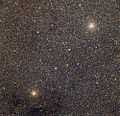| NGC 6522 | |
|---|---|
 | |
| Observation data (J2000 epoch) | |
| Class | VI |
| Constellation | Sagittarius |
| Right ascension | 18 03 34.08 |
| Declination | −30° 02′ 02.3″ |
| Distance | 25.1 kly (7.7 kpc) |
| Apparent magnitude (V) | 8.3 |
| Apparent dimensions (V) | 9.4′ |
| Physical characteristics | |
| Absolute magnitude | −7.67 |
| Mass | 5.93×10 M☉ |
| Metallicity | = –1.34 dex |
| Estimated age | 12.0 Gyr |
| Other designations | GCl 82, C 1800-300 |
| See also: Globular cluster, List of globular clusters | |
NGC 6522 is a globular cluster of stars in the southern constellation of Sagittarius. It was discovered by German-British astronomer William Herschel on June 24, 1784. The cluster has an apparent visual magnitude of 8.3 and an angular diameter of 9.4′. It is located at a distance of 25.1 kly (7.7 kpc) from the Sun, and lies in the Milky Way's central bulge, about 2.0 kly (0.6 kpc) from the Galactic Center. The cluster is centered in a region of the sky known as Baade's Window. It is highly impacted by reddening due to interstellar dust and the view is heavily contaminated by field stars, making it more difficult identify members.
NGC 6522 is possibly the oldest star cluster in the Milky Way, with an age of more than 12 billion years. It is a core collapsed cluster with a core radius of 0.5′ and a 1.0′ half-light radius. The cluster formed four billion years before the Milky Way galactic bar appeared, and may have been confined to the bar for a period of time. At present it trails the bar in its orbit around the core.
This is a low mass globular cluster with an estimated 5.93×10 times the mass of the Sun. Distinctive chemical abundances among the members indicate the cluster has multiple populations of stars, with the younger populations exhibiting pollution from earlier generations. Twenty variable stars have been identified as members of NGC 6522, consisting of eight RR Lyrae, three type II Cepheids, and nine long-period variable stars. Six pulsars have been discovered.
Gallery
-
 The globular clusters NGC 6528 (lower left) is close to NGC 6522 (upper right)
The globular clusters NGC 6528 (lower left) is close to NGC 6522 (upper right)
-
 The cluster is located in Baade's Window, a region of night sky that is not clouded by dust from the Milky Way.
The cluster is located in Baade's Window, a region of night sky that is not clouded by dust from the Milky Way.
References
- ^ Di Criscienzo, M.; et al. (February 2006). "RR Lyrae-based calibration of the Globular Cluster Luminosity Function". Monthly Notices of the Royal Astronomical Society. 365 (4): 1357–1366. arXiv:astro-ph/0511128. Bibcode:2006MNRAS.365.1357D. doi:10.1111/j.1365-2966.2005.09819.x. S2CID 17838243.
- ^ Boyles, J.; et al. (November 2011). "Young Radio Pulsars in Galactic Globular Clusters". The Astrophysical Journal. 742 (1): 51. arXiv:1108.4402. Bibcode:2011ApJ...742...51B. doi:10.1088/0004-637X/742/1/51. S2CID 118649860.
- ^ O'Meara, Stephen James (2013). Deep-Sky Companions: Southern Gems. Cambridge University Press. p. 367. ISBN 9781107015012.
- ^ Fernández-Trincado, J. G.; et al. (July 2019). "H-band discovery of additional second-generation stars in the Galactic bulge globular cluster NGC 6522 as observed by APOGEE and Gaia". Astronomy & Astrophysics. 627. id. A178. arXiv:1801.07136. Bibcode:2019A&A...627A.178F. doi:10.1051/0004-6361/201834391.
- Koleva, M.; et al. (April 2008). "Spectroscopic ages and metallicities of stellar populations: validation of full spectrum fitting". Monthly Notices of the Royal Astronomical Society. 385 (4): 1998–2010. arXiv:0801.0871. Bibcode:2008MNRAS.385.1998K. doi:10.1111/j.1365-2966.2008.12908.x. S2CID 17571531.
- "SIMBAD Astronomical Database". Results for NGC 6522. Retrieved 2011-03-13.
- Ness, Melissa; et al. (December 2014). "NGC 6522: a typical globular cluster in the Galactic bulge without signatures of rapidly rotating Population III stars". Monthly Notices of the Royal Astronomical Society. 445 (3): 2994−2998. arXiv:1408.0290. Bibcode:2014MNRAS.445.2994N. doi:10.1093/mnras/stu2144.
- "NGC 6522". Students for the Exploration and Development of Space. Retrieved 2020-09-23.
- ^ Arellano Ferro, A.; et al. (October 2023). "Variable stars in the field of the Galactic bulge globular cluster NGC 6522". Astrophysics and Space Science. 368 (10). id. 91. arXiv:2310.16257. Bibcode:2023Ap&SS.368...91A. doi:10.1007/s10509-023-04249-4.
- Barbuy, B.; et al. (November 2009). "VLT-FLAMES Analysis of 8 giants in the Bulge Metal-poor Globular Cluster NGC 6522: Oldest Cluster in the Galaxy?". Astronomy and Astrophysics. 507 (1): 405–415. arXiv:0908.3603. Bibcode:2009A&A...507..405B. doi:10.1051/0004-6361/200912748.
- Shiga, David (30 April 2011). "The universe's first stars were whirling dervishes". New Scientist: 20. Retrieved 2024-09-09.
- Chiappini, Cristina; et al. (28 April 2011). "Imprints of fast-rotating massive stars in the Galactic Bulge". Nature. 472 (7344): 454–457. Bibcode:2011Natur.472..454C. doi:10.1038/nature10000. PMID 21525928.
- Barbuy, B.; et al. (October 2021). "UVES analysis of red giants in the bulge globular cluster NGC 6522". Astronomy & Astrophysics. 654. id. A29. arXiv:2107.08746. Bibcode:2021A&A...654A..29B. doi:10.1051/0004-6361/202140815.
- Abbate, F.; et al. (December 2023). "A MeerKAT view of the pulsars in the globular cluster NGC 6522". Astronomy & Astrophysics. 680. id. A47. arXiv:2310.03800. Bibcode:2023A&A...680A..47A. doi:10.1051/0004-6361/202347725.
External links
 Media related to NGC 6522 at Wikimedia Commons
Media related to NGC 6522 at Wikimedia Commons- NGC6522, Galactic Globular Clusters Database page
 = –1.34
= –1.34